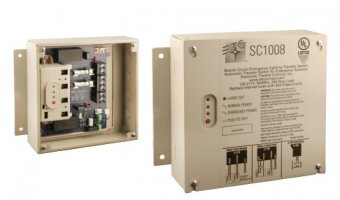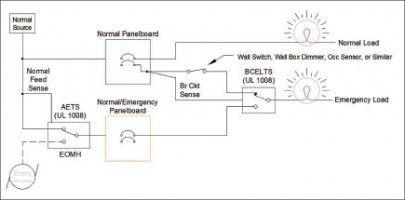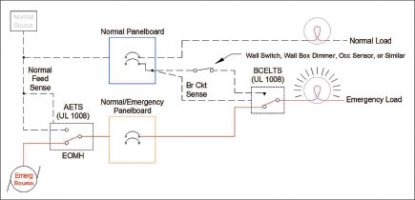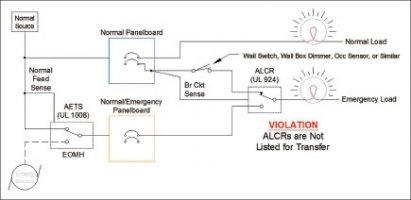jar546
Forum Coordinator
There have been a pile of changes to the NEC over the years, one of the more straightforward sections has been Emergency Lighting. That was, until the last 3 code cycles when things started changing the game.
Here is this article and the original article is available in a link at the bottom.
New Rules and New Tools for Emergency Lighting Control
By
Steve Terry, Mitch Hefter, Ken Vannice
February 28, 2017
In the last few years, advancements in control technology and energy management have made compliance with National Electrical Code, Article 700, Emergency, more complex, with far more design choices available to the specifier or installer. In the March/April 2011 issue of IAEI News the requirements and practices of the time were reviewed and several examples were explained in our article “Understanding Control of Emergency Lighting Circuits.” Continuing upgrades to the NEC and UL standards as well as advances in equipment are now explained in this update.
NEC section 700.1 and the definition of emergency systems in section 700.2 make it clear that emergency systems are to automatically provide power and illumination. While it is possible to provide power and not actually use it for some emergency purpose, the word “illumination” dictates that light must automatically be provided. Consequently, any switching or control in lighting circuits must be automatically forced on in order to comply.
Switching Equipment
One method of accomplishing the above requirements is by using an automatic emergency transfer switch (AETS) to connect the lighting circuits to normal or emergency power. Applying AETS devices to feeders is a common occurrence since typical AETS devices are high-current three or four-pole devices. Historically, AETS devices have also been applied to branch circuits, especially when loads were driven from a dimmer system. But when this type of design has been scaled down and applied to branch circuit applications, the result has often been expensive and over-designed. However, such branch circuit applications of scaled-down large emergency transfer switches were the norm for many years, primarily driven by the requirement of NEC 700.5(C) for all emergency transfer switches to be electrically operated and mechanically held (EOMH).
Despite the mechanically-held requirement of 700.5(C), a class of low-cost transfer-capable devices for use on branch circuits began to appear in the early 2000s. These devices were typically listed as automatic load control relays (ALCR) under UL 924 or as automatic transfer switches suitable for use under Article 702, but notArticle 700. They were non-compliant with 700.5(C) and had not undergone any evaluation as transfer switches for endurance, fault current, and other tests required by the UL 1008 standard for Emergency Transfer Switch Equipment. This situation led to changes in both the NEC and the UL 1008 standard.
First, in the 2011 NEC, automatic load control relays were defined in section 700.2, and section 700.24 was added to specify the requirements of ACLRs. Among those requirements was the statement “The load control relay shall not be used as transfer equipment” which also reflects language in UL 924. Second, UL convened a task group to bring transfer-capable ALCRs that were potentially suitable for use under Article 700 into the UL 1008 standard. The result was a revision to the standard that created a new device: the branch circuit emergency lighting transfer switch (BCELTS). These devices are transfer switches for use on emergency lighting branch circuits rated not over 20 A. While they have no mechanically-held requirement, they are required to undergo all the endurance, fault current, and source interconnection prevention tests of an emergency transfer switch. Third, in the 2017 NEC, BCELTS devices were defined in section 700.2, and section 700.25 has been added detailing the requirements of the BCELTS, specifically removing the mechanically-held requirement of 700.5(C) for these devices.
The result is that there are now two distinct types of branch-circuit devices identified in NEC Article 700, automatic load control relays (ALCR) and branch circuit emergency lighting transfer switches (BCELTS).

Figure 1. Branch Circuit Emergency Lighting Transfer Switch (Photo courtesy Electronic Theatre Controls)

Figure 2a. Proper Use of BCELTS (Normal)

Figure 2b. Proper Use of BCELTS (Emergency)
ALCRs are covered by 700.26 in the 2017 edition of the NEC and Listed to UL 924, Emergency Lighting and Power Equipment, under Category FTBR. Whether or not they appear to have transfer functionality, they are suitable only to bypass switches or control equipment fed from a single normal/emergency source, not to transfer between normal only and normal/emergency sources. The normal/emergency source must be provided via an upstream emergency transfer switch. See figures 3, 4, and 5.

Figure 3a. Improper Use of ALCR for Transfer Function (Normal)
For the rest of this article, please click on this link thanks to the IAEI ( International Association of Electrical Inspectors). If you are an electrical inspector, contractor or engineer/architect, I highly recommend that you join the IAEI.
https://iaeimagazine.org/magazine/2017/02/28/new-rules-and-new-tools-for-emergency-lighting-control/
Here is this article and the original article is available in a link at the bottom.
New Rules and New Tools for Emergency Lighting Control
By
Steve Terry, Mitch Hefter, Ken Vannice
February 28, 2017
In the last few years, advancements in control technology and energy management have made compliance with National Electrical Code, Article 700, Emergency, more complex, with far more design choices available to the specifier or installer. In the March/April 2011 issue of IAEI News the requirements and practices of the time were reviewed and several examples were explained in our article “Understanding Control of Emergency Lighting Circuits.” Continuing upgrades to the NEC and UL standards as well as advances in equipment are now explained in this update.
NEC section 700.1 and the definition of emergency systems in section 700.2 make it clear that emergency systems are to automatically provide power and illumination. While it is possible to provide power and not actually use it for some emergency purpose, the word “illumination” dictates that light must automatically be provided. Consequently, any switching or control in lighting circuits must be automatically forced on in order to comply.
Switching Equipment
One method of accomplishing the above requirements is by using an automatic emergency transfer switch (AETS) to connect the lighting circuits to normal or emergency power. Applying AETS devices to feeders is a common occurrence since typical AETS devices are high-current three or four-pole devices. Historically, AETS devices have also been applied to branch circuits, especially when loads were driven from a dimmer system. But when this type of design has been scaled down and applied to branch circuit applications, the result has often been expensive and over-designed. However, such branch circuit applications of scaled-down large emergency transfer switches were the norm for many years, primarily driven by the requirement of NEC 700.5(C) for all emergency transfer switches to be electrically operated and mechanically held (EOMH).
Despite the mechanically-held requirement of 700.5(C), a class of low-cost transfer-capable devices for use on branch circuits began to appear in the early 2000s. These devices were typically listed as automatic load control relays (ALCR) under UL 924 or as automatic transfer switches suitable for use under Article 702, but notArticle 700. They were non-compliant with 700.5(C) and had not undergone any evaluation as transfer switches for endurance, fault current, and other tests required by the UL 1008 standard for Emergency Transfer Switch Equipment. This situation led to changes in both the NEC and the UL 1008 standard.
First, in the 2011 NEC, automatic load control relays were defined in section 700.2, and section 700.24 was added to specify the requirements of ACLRs. Among those requirements was the statement “The load control relay shall not be used as transfer equipment” which also reflects language in UL 924. Second, UL convened a task group to bring transfer-capable ALCRs that were potentially suitable for use under Article 700 into the UL 1008 standard. The result was a revision to the standard that created a new device: the branch circuit emergency lighting transfer switch (BCELTS). These devices are transfer switches for use on emergency lighting branch circuits rated not over 20 A. While they have no mechanically-held requirement, they are required to undergo all the endurance, fault current, and source interconnection prevention tests of an emergency transfer switch. Third, in the 2017 NEC, BCELTS devices were defined in section 700.2, and section 700.25 has been added detailing the requirements of the BCELTS, specifically removing the mechanically-held requirement of 700.5(C) for these devices.
The result is that there are now two distinct types of branch-circuit devices identified in NEC Article 700, automatic load control relays (ALCR) and branch circuit emergency lighting transfer switches (BCELTS).

Figure 1. Branch Circuit Emergency Lighting Transfer Switch (Photo courtesy Electronic Theatre Controls)

Figure 2a. Proper Use of BCELTS (Normal)

Figure 2b. Proper Use of BCELTS (Emergency)
ALCRs are covered by 700.26 in the 2017 edition of the NEC and Listed to UL 924, Emergency Lighting and Power Equipment, under Category FTBR. Whether or not they appear to have transfer functionality, they are suitable only to bypass switches or control equipment fed from a single normal/emergency source, not to transfer between normal only and normal/emergency sources. The normal/emergency source must be provided via an upstream emergency transfer switch. See figures 3, 4, and 5.

Figure 3a. Improper Use of ALCR for Transfer Function (Normal)
For the rest of this article, please click on this link thanks to the IAEI ( International Association of Electrical Inspectors). If you are an electrical inspector, contractor or engineer/architect, I highly recommend that you join the IAEI.
https://iaeimagazine.org/magazine/2017/02/28/new-rules-and-new-tools-for-emergency-lighting-control/
